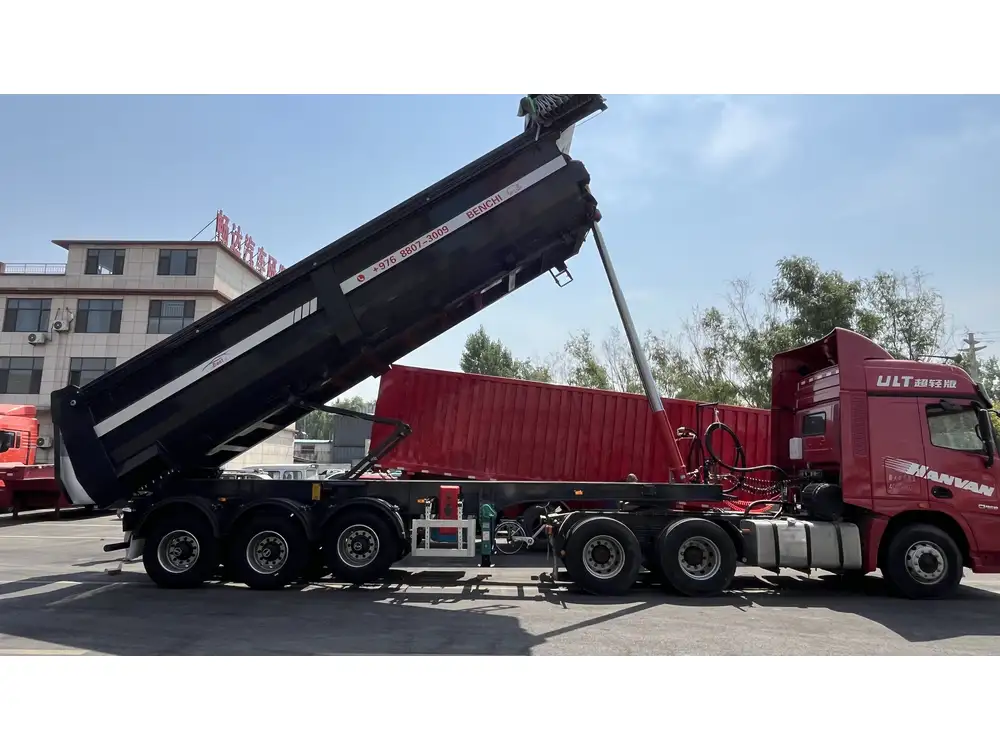Jacking up a semi-trailer is a fundamental skill for professionals in the trucking and logistics industry. Whether it’s for maintenance, repairs, or tire changes, performing this task safely is paramount. In this guide, we provide a detailed, step-by-step approach to effectively and safely jack up a semi-trailer, ensuring that safety regulations are adhered to strictly.
Understanding the Basics of Semi-Trailer Dynamics
Before diving into the jacking process, it’s crucial to understand the semi-trailer’s structure and weight dynamics. A typical semi-trailer can weigh between 30,000 to 40,000 pounds without cargo. When cargo is loaded, this weight can escalate significantly. Here are a few components to note:
| Component | Description |
|---|---|
| Axles | Support the trailer and carry the load. |
| Landing Gear | Stabilizes the trailer when detached from the truck. |
| Frame | The structural skeleton that holds everything together. |
| Wheels/Tires | Allow movement and must be properly inflated. |
Understanding these components is crucial for identifying the appropriate jacking points and methods.
Important Safety Measures

Personal Protective Equipment (PPE)
Before beginning any jacking operation, ensure that you are equipped with the following PPE:
- Hard Hat: Safeguards against falling objects.
- Steel-Toe Boots: Protects your feet from crushing injuries.
- Gloves: Ensures a good grip while operating tools.
- Safety Glasses: Shields your eyes from debris.
Site Preparation and Inspection
The groundwork of a successful lifting operation begins with site preparation. Follow these steps:
- Inspect the Area: Ensure that the ground is level, firm, and free from debris.
- Check for Hazards: Look for overhead power lines, uneven surfaces, or other dangers.
- Secure the Trailer: Make certain the trailer is parked on a level surface and secured with wheel chocks.
Equipment Required
To jack up a semi-trailer effectively, you will need the following equipment:
- Hydraulic Jack: A suitable hydraulic jack rated for the trailer’s weight.
- Jack Stands: To provide additional support once the trailer is elevated.
- Wheel Chocks: To prevent rolling during the process.
- Ramps (Optional): For increased height when needed.

Step-by-Step Guide to Jacking Up a Semi-Trailer
Now, let’s break down the jacking process into manageable steps.
Step 1: Positioning the Trailer
Carefully position the trailer in a safe area away from busy traffic.
- Set the Brakes: Engage the parking brakes fully.
- Chock the Wheels: Place wheel chocks in front of the tires to prevent any movement.
Step 2: Locate the Jack Points
Identifying the proper jacking points is essential to maximizing safety. Typically, the best jacking points are:
- Near the Axles: Placing the jack directly under the axle, ensuring no brake lines, electrical cables, or other components are in the way.
- On the Frame: If more lift is necessary, position the jack on the trailer’s frame cross members.

Step 3: Setting Up the Hydraulic Jack
- Position the Jack: Ensure the hydraulic jack is centered at the selected jacking point.
- Adjust Height: If instructed, adjust the jack to meet the trailer’s base without applying full pressure.
Step 4: Lifting the Trailer
Carefully begin the lifting process:
- Engage the Jack: Pump the handle slowly, observing the trailer’s reaction.
- Lift Gradually: Slowly raise the trailer until it reaches the desired height, monitoring for stability.
Step 5: Installing Jack Stands
Once lifted to the desired height:
- Place Jack Stands: Position jack stands under the trailer’s frame adjacent to the jack.
- Lower the Trailer: Slowly release the jack to lower the trailer onto the jack stands.
- Ensure Stability: Gently push on the trailer to ensure the jack stands can tolerate the weight.

Step 6: Performing Necessary Maintenance or Repair
With the trailer securely supported, you can now perform the required maintenance tasks, such as:
- Tire Changes: Swap out any flat or worn tires.
- Brake Inspections: Check the braking system for wear.
- Suspension Checks: Look for any signs of damage or wear in suspension components.
Step 7: Lowering the Trailer
Once your work is complete, carefully follow these steps to lower the trailer:
- Remove Equipment: Clear all tools and materials from the area.
- Remove Jack Stands: Carefully jack up the trailer slightly to remove the stands.
- Engage the Hydraulic Jack: Raise the trailer back to the original height.
- Lower the Trailer: Release the jack slowly while ensuring stability throughout the process.
Common Mistakes to Avoid
Jacking up a semi-trailer can be fraught with pitfalls. Here are common mistakes to avoid:
- Ignoring Ground Stability: Before the operation, always check that the area is level and solid.
- Neglecting Safety Gear: Ensure all personnel are wearing appropriate protective gear.
- Using Faulty Equipment: Regularly inspect jacks and stands for wear and defects.
- Overloading Jacks: Ensure that the jack’s capacity exceeds the total weight of the trailer.

Best Practices for Long-term Trailer Care
To extend the life of your semi-trailers and avoid emergencies requiring jacking, consider these maintenance tips:
- Regular Inspections: Conduct routine maintenance checks on tires, brakes, and suspension.
- Stay Organized: Maintain a logbook of inspections, repairs, and service dates.
- Professional Help: If unsure about maintenance, consult a professional mechanic.
Conclusion
Mastering the art of jacking up a semi-trailer is not only fundamental for effective maintenance but also crucial for ensuring safety. By diligently adhering to the guidelines outlined in this comprehensive guide, you will equip yourself with the knowledge to perform this task correctly.
Engaging in thorough preparation, employing the right tools, and observing safety protocols are all part of the maintenance framework that protects both the operator and the equipment alike.
Enhancing your competency in this area can lead not only to better trailer longevity but also to significant time and cost savings. Always remember, when in doubt, prioritize safety and consult with professionals if any complications arise.
For additional resources or expert maintenance services, feel free to reach out to our customer support team—your journey in maintaining your semi-trailer starts with proper knowledge and execution.



